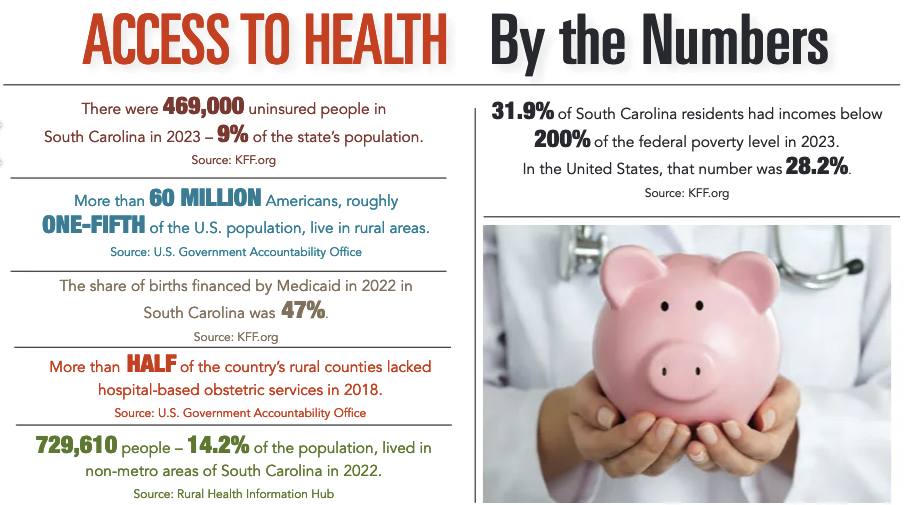It’s 2025, and society seems to be more advanced than ever. After all, technology virtually gives us the world at our fingertips. But tangible access to things like adequate health care remain out of reach for many. If you live in the hustle and bustle of a well-populated area, most health-related necessities are woven into daily life – something many new and expecting mothers in those areas can take for granted. Yet for those in the 11 rural South Carolina counties that are devoid of an obstetrician, lack of access to proper medical care and health education is still a significant concern.
“The data starts to paint the picture of the struggle of moms in rural areas,” explained Danielle Wingo, Maternal and Child Health Bureau director for South Carolina’s Department of Public Health. “Unfortunately that’s where we see a higher number of maternal mortality and, in some cases, infant mortality as well. “
The DPH reported data illustrating that the pregnancy-related mortality rate for mothers is nearly twice as high in rural areas as it is in urban areas in South Carolina. Of those deaths, mental health conditions and substance use disorders were the leading causes of pregnancy-related maternal death, closely followed by thrombotic embolism and cardiomyopathy. Most of these deaths were found to be preventable.
While it may sound easy enough to simply set up an obstetrician in rural counties, the reality is not so simple. “We’ve seen a decrease in obstetricians throughout the entire state, but being an obstetrician is extremely challenging in a rural area,” Wingo explained. The demands of being on call around the clock for an entire county, and often neighboring counties, result in a high burnout rate.
Transportation to medical appointments presents another barrier to health access for new and expecting mothers in rural areas. Finding a reliable mode of transportation, taking time off from work not only for appointments but for considerable travel time and arranging for child care are just some of the real-world concerns that are easily underappreciated in urban areas.
However, there are efforts being made to bridge the distance to access proper care in rural communities. The DPH is currently seeking funding for a mobile maternity unit that would routinely travel to rural communities and provide OB services.
Major hospital systems also are working to address the problem. “Pregnant women who don’t have a birthing hospital in their area wind up going to the nearest emergency room,” Wingo said. “There are grants in place for educating emergency room physicians on how to birth babies, but there are also circumstances where births are complicated. Educating for emergency room births is not a final solution, but it’s a step in the right direction.”
A lack of access to healthy, affordable foods also presents a challenge for those in rural communities. “I look at my grocery bill and don’t know how people struggling to make ends meet could provide healthy food. Food that’s not good for you is cheaper and takes less time to prepare,” said Alice LoGuidice, owner of Empowered Children’s Wellness. But the more affordable food comes at a cost to your health.
“When women are pregnant, we know what they ingest very much correlates to their children,” she said.
While addressing these health concerns at their root causes would be ideal, LoGuidice suggested that to solve immediate health care needs, putting a proverbial Band-Aid on the issues is often what happens in order to alleviate present and pressing health issues.
The United States Department of Agriculture’s Women, Infants and Children program provides a Band-Aid of sorts for proper nutrition. The program offers federal grants to states to help with nutritional supplemental foods and nutrition education specifically for low-income pregnant and postpartum women and to infants and children up to age 5.
“Education and access to healthy nutrition through WIC can improve health of the mother and baby,” Wingo said. “Inadequate nutrition can contribute to obesity and chronic depression, and those factors can affect the health of the mom before, during and after pregnancy. These can contribute to complications with low birth weight or birth defects.”
Low birth weight and birth defects are leading causes of infant mortality; however, infant deaths due to accidents are significantly on the rise, mostly due to accidental suffocation and strangulation in bed.
To improve these grim numbers, the Department of Public Health is working to improve access and communication to educate pregnant women about safe sleep practices. There is even an educational video on the subject that new mothers are required to watch before leaving the hospital.
Other health education campaigns for new and expecting mothers are being shared as well. Count the Kicks is a fetal movement tracking app that is a simple way for expecting mothers to connect with their unborn babies and be aware of movement patterns that might signal a need for medical help.
The Centers for Disease Control and Prevention’s HEAR HER Campaign is helping create awareness of urgent maternal warning signs for pregnant and postpartum women, with a goal of eliminating preventable maternal mortality.
“A good portion of our state is considered rural,” Wingo stated. “There are disparities between urban and rural areas, and there are an abundance of efforts with our agency and many others to tackle this. We’re trying to get the word out and get funding to reach and improve the lives of as many people as we can in these communities.”
By Anne Toole








